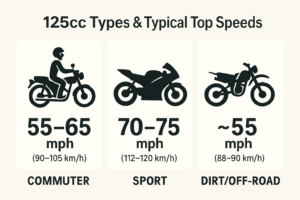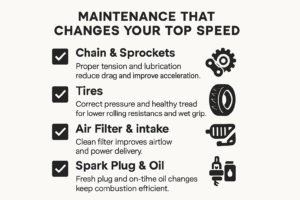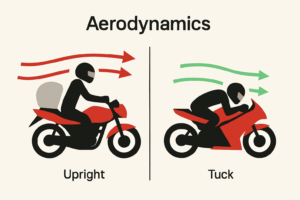125cc 摩托车在平地上全油门行驶时的最高速度通常在 90-120 公里/小时(55-75 英里/小时)之间。具体速度取决于车型、骑行者体重和路况。由于大多数 125cc 摩托车的功率输出和传动装置设计相似,因此其最高速度自然会限制在这个范围内。
对于初学者和通勤者来说,这种速度和控制的平衡在城市交通中提供了可靠的性能,同时仍然能够在短途高速公路上行驶 - 这使得 125cc 自行车成为一种实用且灵活的移动选择。
一旦您读完这篇文章,您将掌握所有原始事实和微妙的观点,这将使您能够非常自信地说出 125cc 的自行车是否适合您。
目录
切换125cc摩托车是什么意思?定义和原理
让我们从基础开始:
125cc的定义
“CC”代表立方厘米,指的是发动机排量。它测量的是发动机总体积。 空气-燃料混合物 发动机的气缸在一个完整循环中可以吸入多少马力。例如,一台125cc的摩托车发动机在一个工作循环中可以将125立方厘米的混合气排到所有气缸中。排量直接反映了摩托车发动机的功率和效率。排量越大,燃油消耗越多,扭矩也越大,而排量较小的发动机则更注重效率和操控性。一台125cc的发动机通常可以产生10到15马力的功率,足以满足日常通勤的舒适需求,而不会感到压力。
125cc摩托车的原理
功率重量比:标准的125cc摩托车重量约为250至350磅(113至159公斤)。马力大约在10到15之间,这是一个合理的比例,既能平衡稳定的加速,又不会让骑手感到压力过大。
无障碍设施在许多国家,新手摩托车骑手只需持有最低驾照即可驾驶超过基本驾驶能力的125cc摩托车。例如,在英国,持有CBT(强制性基本培训)证书即可。
常见的125cc摩托车
街道125cc摩托车主要有三种:
125cc通勤自行车
这款摩托车实用性较高,但作为通勤摩托车来说非常值得信赖;它拥有直立的骑行姿势,操控简单,并且在城市长途驾驶中也考虑到了舒适性。大多数这类摩托车的平均时速在 55 至 65 英里/小时(90-105 公里/小时)之间;几乎可以完美适应所有城市街道和郊区通勤。
它们的燃油经济性相当出色,就其价格而言,许多车型的油耗超过100英里/加仑(40公里/升以上)。它们的维护成本也非常低,非常适合学生、专业人士或任何只需要经济实惠的日常代步工具的人。
运动型125cc摩托车
这些是125cc的运动型摩托车,但这些发动机的排量却完全相同,尽管这已经将发动机的性能推到了极限。更高的转速强调了健康的转速,以及出色的 空气动力学整流罩,并且在激进的骑行姿势下,其最高速度范围通常在每小时 70 至 75 英里(112 至 120 公里/小时)范围内。
125cc 越野摩托车
125cc 越野摩托车和泥地摩托车都拥有强大的动力,能够应对几乎任何地形。它们采用轻量化车架、长行程悬挂和耐用轮胎,足以应对泥泞、沙地和碎石路况。通常情况下,这些摩托车的最高时速限制在 55 英里/小时(90 公里/小时)左右,但它们的强项在于爬坡、穿越崎岖道路以及应对最严酷的路况。

125cc 的摩托车速度有多快?
一些例子 越野摩托车 125 可能包括:
雅马哈 YZF-R125 运动型摩托车: 72 英里/小时(116 公里/小时)
本田CB125F通勤车: 65 英里/小时(104 公里/小时)
川崎KLX125泥地车型: 55 英里/小时(88 公里/小时)
所有这些数据都表明,125cc 的摩托车并不适合高速公路,但其性能足以轻松应对郊区和城镇的交通。
比较表:发动机尺寸与速度
| 发动机尺寸 | 平均马力 | 典型最高速度(英里/小时/公里/小时) | 理想用例 |
|---|---|---|---|
| 50cc | 3–5马力 | 30–40 英里/小时(48–64 公里/小时) | 城市滑板车,学习者 |
| 125cc | 10–15马力 | 55–75 英里/小时(90–120 公里/小时) | 通勤者、首次骑行者 |
| 250cc | 20–30马力 | 80–95 英里/小时(128–153 公里/小时) | 轻度旅行、短途高速公路行驶 |
| 600cc | 80–120 马力 | 130–160 英里/小时(209–257 公里/小时) | 高速公路、运动爱好者 |
影响速度的因素
速度 125cc自行车 是一个受日常因素、骑行者和机械因素影响的变量。在实际情况下,一辆标称时速 70 英里的摩托车可能只能达到 62 英里/小时。了解这些变量可以帮助骑行者将摩托车推向安全极限,同时延长摩托车的整个使用寿命。

骑手与负载
125cc 的最高速度取决于重量和负载。骑行者的体重是影响性能的一个非常重要的因素。一个体重 150 磅(68 公斤)的人骑着 125cc 的摩托车在平坦路面上可以轻松达到 70 英里/小时(112 公里/小时)的速度。然而,如果再加上一个体重 200 磅(90 公斤)的乘客和一个绑在后部的行李包,摩托车就会突然陷入与重力和阻力的斗争中,速度实际上会降到 60 英里/小时(96 公里/小时)左右。
加速性能也说明了同样的道理。单凭加速性能,你可能在12-14秒内就能加速到0-60英里/小时,这对于小型发动机来说已经很出色了。但如果加上额外的负载,同一辆摩托车在这个速度下需要16-18秒。
地形和天气
每次路况变化时,125cc 巡洋舰的响应与全尺寸摩托车不同。我们来看一些例子。
丘陵:山坡就像是发动机的天然阻力训练;在陡峭的坡度上,您的最大速度可能会降低约 10 至 15 英里/小时。
风:强风可使速度降低 10% 至 20%;因此,额定速度为 70 英里/小时的自行车的速度将降低 55 至 60 英里/小时。
道路状况:平整的沥青路面骑行更平稳。但如果遇到碎石、坑洼或湿滑路面,骑手必须松开油门。这不仅关乎安全,也关乎操控。

125cc摩托车的优点和缺点
谈到 125cc 运动摩托车时,有一些优点和缺点:
125cc摩托车的优势
燃油效率:90-110英里/加仑
到目前为止,125cc 摩托车的主要吸引力之一就是燃油效率。许多型号的燃油效率高达每加仑 90 至 110 英里(38-46 公里/升),这使得它们比大多数踏板车和几乎所有汽车都更省油。对于每天骑行 20-30 英里的通勤者来说,燃油成本相当于一周交通预算中的一分钱。事实上,一些骑手开玩笑说,他们喝咖啡的习惯比汽油费还贵。这种效率对学生、年轻专业人士或其他任何注重降低交通成本的人来说都更具吸引力。
成本:平均在 $2,000 至 $4,000 之间
与中型或大型摩托车相比,125cc 摩托车价格非常实惠。全新车型的价格通常在 $2,000 到 $4,000 之间,具体取决于款式和功能。一些二手车状况良好,价格低至 $1200。再加上较低的维修成本和更便宜的零件,可以看出,125cc 摩托车的总拥有成本远低于大型摩托车。对许多人来说,125cc 摩托车是理想的“入门门票”,无需花费太多。
对于初学者来说:轻量且宽容
大多数 125cc 摩托车的重量约为 250-350 磅(113-159 公斤),远轻于重约 500-600 磅的中型摩托车。由于重量较轻,新手骑手几乎可以轻松保持平衡、操控和停车,不用担心翻车。动力输出也更具适应性,加速平顺、可预测,不会出现突然的扭矩爆发。正因如此,世界各地的许多培训机构都选择 125cc 摩托车进行驾照培训:它们既不令人望而生畏,又在大多数情况下动力强劲,足以教授正确的骑行技巧。
125cc 摩托车的缺点
最高速度:不太适合高速公路
125cc发动机最烦人的地方在于最高速度。它的大部分速度都很难超过55-75英里/小时(90-120公里/小时),几乎跟不上高速公路上时速70-80英里的车流。这会让长途骑行或高速公路骑行变得相当吃力,因为你必须让发动机保持在极限转速,才能应对来来往往的车辆。虽然在城市或郊区驾驶时,这个速度还算可以接受,但在高端旅行中就不行了。
快速成长:更多动力
大多数人拥有第一辆摩托车后,都会觉得它很完美,最多一两年后,就会想要更强劲的动力。随着骑行信心的增强,125cc 的局限性(例如加速较慢和最高速度受限)会变得更加明显,这通常会促使他们升级到更大的排量,例如 250cc、300cc 甚至 600cc 的摩托车。简而言之,虽然 125cc 对初学者来说确实很棒,但它很少能满足长期摩托车骑行的愿望。
负载敏感性:乘客或行李越多,性能越差
由于发动机较小,125cc 摩托车会受到额外载重的影响。单人骑行时,如果以 70 英里/小时的速度行驶,如果增加乘客或行李,速度可能会降至 60 英里/小时甚至更低。加速性能也会受到影响,超车时会感觉迟钝。这使得它们不太适合旅行或双人骑行。它们是通勤的好帮手,但不适合重载或长途旅行。
以低预算获得优质、快速的125cc摩托车
如果您正在寻找速度、舒适度和经济性之间的完美平衡,那么 125cc 摩托车是一个不错的选择。BS电机 以其坚固耐用和可靠的摩托车而闻名,尤其是在125cc排量摩托车领域。该公司专注于越野和通勤车型,在价格和耐用性之间取得平衡。骑手们选择BSEMotors,是因为它们拥有经久耐用的摩托车,能够在各种地形中出色地行驶,同时又不牺牲价格和便捷的售后服务。
常见问题解答
我需要 125cc 的特殊驾照吗?
当然,需要驾照,而且各国对最快的125cc摩托车的监管规定也有所不同。在英国,年满17岁即可持有CBT证书驾驶125cc摩托车,并且在升级之前不得在高速公路上行驶。在欧洲几乎所有地方,A1驾照都适用于125cc摩托车,而在美国,您需要摩托车认证或M级驾照。这样做的好处是,与大型摩托车相比,合法驾驶摩托车的途径更加简单快捷。
125cc能用多久?
一台运转良好的125cc发动机可以轻松行驶3万到5万英里,并进行一些重要的发动机维护后才需要保养。其使用寿命取决于骑行习惯;如果通勤者骑行保守且定期进行保养,则可能行驶超过5万英里;而如果骑手总是将摩托车推到极限,则磨损会更快。良好的习惯意味着按时换油、保养链条,并且避免过度加速;这些确实很重要。
125cc 的转售价值是多少?
125cc 摩托车的转售价格较高,因为它们是新手骑手的最爱。如果保养得当且没有发生过事故,一辆两年车龄的摩托车应该能保留其原始价值的 60-70% 左右。本田、雅马哈和 KTM 等品牌的摩托车往往比知名度较低的品牌价值更高。买家通常是学生或新手骑手,他们更倾向于选择价格较低的摩托车。
如果您想了解不同排量越野摩托车发动机的性能对比,请浏览我们的完整速度系列。从小型入门级车型到高性能机器,我们详细列出了每个类别中的最高速度:
50cc越野摩托车能跑多快?
110cc越野摩托车能跑多快
150cc越野摩托车能跑多快?
250cc越野摩托车能跑多快?
350cc越野摩托车能跑多快?
450cc越野摩托车能跑多快?
600cc越野摩托车能跑多快?
